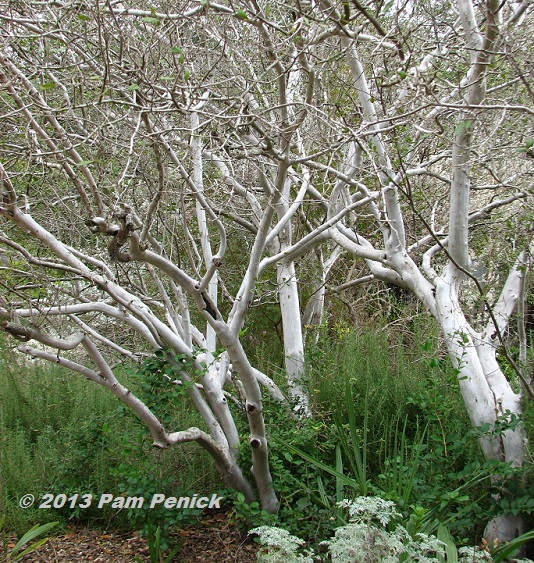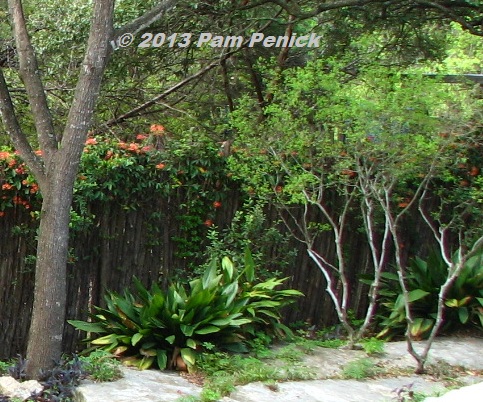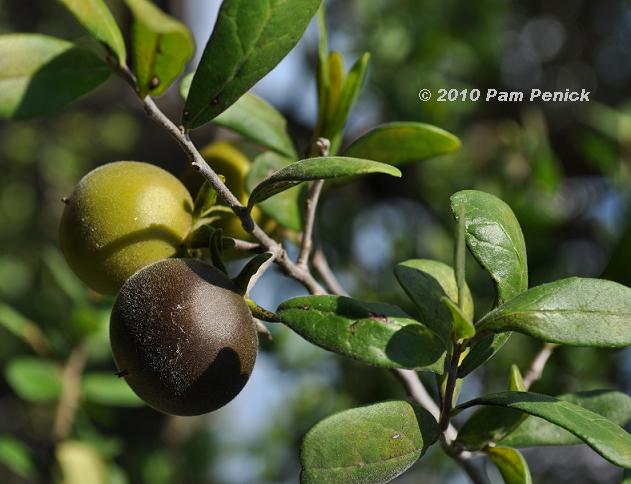Plant This: Texas persimmon
One of my favorite small trees for winter interest is Texas persimmon (Diospyros texana), which occurs naturally in central and south Texas but is found as far east as Houston and as far west as Big Bend National Park. This picture, which I took at a client’s house yesterday, shows why you’d want it in your garden: just look at those milky white, muscular trunks and branches! They attract attention all year but really stand out during our quieter winters, when gray-green and tan are the dominant hues. I like how these homeowners have planted deep-green rosemary beneath their stand of persimmons, offering a nice contrast with the white trunks.
In my own garden, I inherited a number of Texas persimmons, several of which are growing in cracks between huge slabs of limestone. This is, as you can see, a tough, drought-tolerant tree. Growth is slow, and so it’s probably priced higher than faster-growing trees at the nursery. Give it well-drained soil and full sun to part sun.
I think Texas persimmon looks best pruned up into a multi-trunked small tree, like a crepe myrtle, the better to show off the white trunks and branches. Unlike a crepe myrtle, however, Texas persimmon lacks showy, colorful flowers, and its leathery, small leaves aren’t much to write home about either. It’s really all about the bark and shapely limbs.
Texas persimmon is described as semi-evergreen. In Austin some trees drop their leaves in winter (like the ones pictured at top) and others, like mine, simply thin out and then drop their leaves in late winter, with only a month of bare branches before the new leaves appear. Others, especially further south, hold onto their leaves all winter and only drop them as the new leaves come in, just as live oaks do.
The small black fruit (about 1 inch diameter), which appears in early fall, occurs only on female trees. All my trees are male, apparently, because I never see any of the dark, berry-like persimmons, which are edible and also a favorite of wildlife. That’s fine with me, since my biggest Texas persimmon hangs partially over our pool. Update 8/15: One of the trees does actually produce fruit, so I know it’s female.
So if you need a 10-15 ft. tree for a hot, sunny spot with rocky soil, or even a well-drained spot with some clay and some shade, try Texas persimmon. Look for it at Barton Springs Nursery, the Natural Gardener, or the Wildflower Center’s spring native-plant sale.
Note: My Plant This posts are written primarily for gardeners in central Texas. The plants I recommend are ones I’ve grown myself and have direct experience with. I wish I could provide more information about how these plants might perform in other parts of the country, but gardening knowledge is local. Consider checking your local online gardening forums to see if a particular plant might work in your region.
All material © 2006-2013 by Pam Penick for Digging. Unauthorized reproduction prohibited.





That silver color is dreamy & reminds me of driftwood. Your trees stand out nicely against the darkness of the fence behind.
I agree, Peter, and I can’t take credit for it because both the cedar fence and the persimmons were here when we moved in. —Pam
Texas Persimmon is one of my favorite small trees, and I agree the wonderful bark is what sets it apart. There is a large one in the woods near my house that some kids and I have named Mrs. Bones because of its a white knobby trunk. Pam, you’ve described it wonderfully.
Mrs. Bones—what a great name for a charismatic tree. Plus, you’re teaching kids to notice and appreciate wild plants and nature—bravo! —Pam
Pam, I love your designs and everything about your site. How will these do in California? I live in Santa Rosa. It would be nice to see more info about zones or some other clue about where to grow the plants you feature.
Thanks.
Hi, Kirsten. Thanks so much for reading! I wish I could answer your question about how Texas persimmon would do in CA, but I really have no idea. I find that gardening knowledge is very localized, and I’ve never gardened in CA. You might check your regional gardening forums to see if anyone has tried it in your region. —Pam
Gorgeous tree! Thanks for the recommendation.
My pleasure, Amy. —Pam
Love the photo of the fruit – I’ve wondered why I never have any, so I guess all my trees are male as well.
Will the nurseries/sellers you listed above be able to accurately tell me whether they are selling me a male? Which seller is most reliable that way? I’d like a male, to skip the berries. Do the youngest females possibly not produce fruit, making them easy to mistake for males? And is there any advantage, pollination-wise, with having a male and a female within proximity of each other (because these plants are dioecious)? At what “mature” age do they finally lose their bark to show those beautiful white trunks? Will it take more than 6-8 years to get those thick white trunks? Last, for reasons of ornamentation, I’d like to flatten out the trunks into one plane. Do you think sandwiching the trunks of a young plant between two pieces of plywood, with some padding, would start that out right? Thanks!